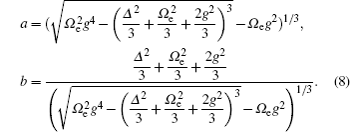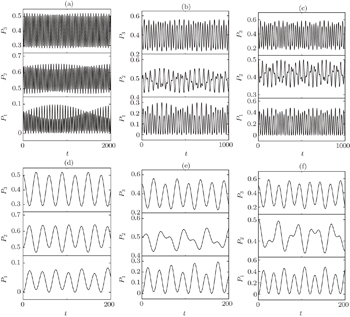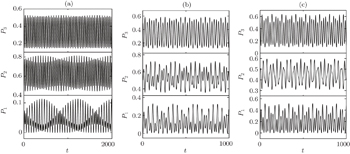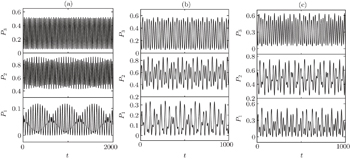† Corresponding author. E-mail:
Project supported by the National Natural Science Foundation of China (Grant Nos. 11434017 and 11374357) and the National Basics Research Program of China (Grant No. 2013CB632704).
We discuss the dynamics of a three-level V-type atom driven simultaneously by a cavity photon and microwave field by examining the atomic population evolution. Owing to the coupling effect of the cavity photon, periodical oscillation of the population between the two upper states and the ground state takes place, which is the well-known vacuum Rabi oscillation. Meanwhile, the population exchange between the upmost level and the middle level can occur due to the driving action of the external microwave field. The general dynamic behavior is the superposition of a fast and a slow periodical oscillation under the cooperative and competitive effect of the cavity photon and the microwave field. Numerical results demonstrate that the time evolution of the population is strongly dependent on the atom–cavity coupling coefficient g and Rabi frequency Ωe that reflects the intensity of the external microwave field. By modulating the two parameters g and Ωe, a large number of population transfer behaviors can be achieved.
Cavity quantum electrodynamics (QED) has aroused increasing interest since the Purcell effect was proposed in 1946[1] and testified in a laboratory in 1947.[2] A typical cavity QED system consists of a cavity photon subsystem and an atomic subsystem. A high-finesse cavity confines light into a small volume and holds photons over a long time before dissipation because of its good insulation against the environment. Such an artificial confined structure offers an appropriate stage on which the atom system as a sensitive needle may detect weak variation from the background and show a series of new and interesting effects. By means of these effects we may understand the fundamental problems of light-matter interaction and the basic properties of the changed vacuum field. A variety of theoretical and experimental subjects utilizing the cavity QED system have been explored over the past years, including enhanced or weakened quantum interference effects,[3–5] a change of spontaneous emission,[6–9] electromagnetically induced transparency,[10–12] population dynamics or quantum state manipulation.[13–16]
Among all the above topics, the dynamics control of quantum states is of crucial importance for practical applications in quantum physics. In the past few years various measures have been adopted to control the dynamics of quantum states or population trapping.[17–27] For instance, in a two-coupled atom–cavity system, a wide variety of time-evolution behaviors have been shown by modulating the coupling strength and the hopping strength.[17] For two Λ-type atoms inside a cavity, a nonadiabatic scheme to accelerate the population transfer and the creation of maximal entanglement between two atoms has been proposed in line with Berry’s transitionless quantum driving approach.[24] Moreover, population trapping in the excited state arises if a two-level atom is embedded in a dissipative cavity, which is coupled to a bosonic environment.[25] Besides, a laser field is frequently used independently or jointly with a cavity field to manipulate population cooling or inversion[28–34] and a radio-frequency field is also applied to fine structure systems.[35] For a V-type three-level atom with two upper states close in energy levels, the usual way to control the dynamics of an atom is to use two different lasers with their wavelengths finely and appropriately tuned. Yet, using the combination of a microwave field with a much lower frequency together with a laser field can also be an alternative way to provide a feasible measure to control the interaction between an atom and a field. To our knowledge, such a scheme has not been studied. Therefore, in order to understand the properties of the single atom–cavity system more broadly and deeply, it is meaningful to study the dynamics of population for a V-type three-level atom–cavity coupling system driven by an external microwave field.
In this paper, we present a scheme of population transfer among different quantum states for a three-level V-type atom confined in a single-mode cavity. Meanwhile, as in an actual situation, a classical microwave field with a much lower frequency than a common laser field is added between the two upper levels of the atom (with two upper states close in energy level). Under the cooperative and competitive operation of the cavity field and the microwave field simultaneously, the system exhibits many freedoms to manipulate the interaction between the atom and cavity, the atom and classical field, including the coupling coefficient (g), the Rabi frequency (Ωe) associated with the external field, the detuning (δ) between the atom and the external field, the detuning (Δ) between the atom and the cavity field, and initial conditions. The coupling coefficient g (g = D(ωc/2ħɛ0V)1/2, where D is the atomic dipole moment, ωc is the frequency of the cavity mode, ħ is the Planck constant, ɛ0 is the vacuum permittivity, V is the cavity mode volume)[36] reflects the strength of the atom–cavity interaction directly. On the other hand, Rabi frequency 

The system considered is depicted in Fig.
In the interaction picture, the Hamiltonian for the system can be described as


Here, a† (a) is the creation (annihilation) operators of the cavity mode; |g〉 and |ei〉 (i = 1, 2) are the ground and excited states of the atom; Δ1 = ωc − (ω1 − ωg) and Δ2 = ωc − (ω2 − ωg) are the detuning between the transition frequency of the two upper levels and the resonant frequency of the cavity mode; Ωe denotes the Rabi frequency of the external driving field; ν is its carrier frequency.
The solution and discussion of the Hamiltonian are restricted to the subspace which contains only zero and one excitations. Thus, the state vector of the system at time t is








In our model, the detuning Δ is set to be 0.1. Therefore, three eigenvalues are only subjected to the influence from the coupling constant g and the Rabi frequency Ωe. A close look at Eq. (
Substitute three eigenvalues into Eq. (



We now assume that the atom is initially prepared in the superposition state of the two upper levels with the same probability amplitude and the cavity is in a vacuum state and given as





It is worth noting from Eqs. (
Since the system involves two types of interactions, some detailed questions, such as the role of each type in shaping the single-excitation dynamics, the difference between the cases without and with external fields, need to be investigated. In the following we control the dynamics of population based on Eq. (
We assume that initially the atom is prepared in the superposition state of the two upper levels and the cavity is in a vacuum state as described in Eq. (
Obviously the atom–cavity system is located in the strongly coupling regime since dissipation is neglected. The spontaneous emission will occur, accompanied by the emission of a photon. Owing to strong coupling interaction, the emitted photon is trapped in the vicinity of the atom by the resonance cavity. The photon may be reabsorbed by the atom. Then the photon will be reemitted and reabsorbed a number of times before it leaves the cavity finally. Numerical results in Fig.
It is interesting to note that energy will not be fully transferred from the upper levels to the lower level every cycle. Perhaps this is due to the detuning between the atom and the cavity mode. As is well known, it is impossible for the three-level V-type atom to be in resonance with the cavity mode completely since there are two transition channels. However, it is easy for a two-level atom to be resonant with the cavity. Therefore, in order to understand the influence of the detuning on the population transfer in depth, we also give the numerical results about the dynamics of a two-level atom–cavity system. For the sake of distinguishing the detuning between the three-level atom and the two-level atom, here we denote the detuning of the two-level atom as Δtwo−level.
The numerical results in Fig. 
 | Fig. 4. Time evolutions of populations for the system containing a two-level atom interacting with a single-mode cavity under the Δtwo − level values of 0 (a), 0.1 (b), and 0.2 (c). |
Now an external microwave field is added to induce the coupling between two excited states of the atom. For simplicity, we only consider the resonance case, i.e., the frequency of external field is equal to the frequency difference between upper levels (ν = |ω21| = 2Δ). Therefore, Rabi frequency can be described as Ωe = |D12 |E0/ħ, where D12 is the dipole matrix element, E0 is the amplitude of the external field, and ħ is the Planck constant. For a certain microwave field, D12 is a fixed value, then Ωe is proportional to E0. In the following a series of time evolutions of population will be shown in Figs.
Rigorous numerical results are shown in Fig.
In order to explain the role of the intensity of the external field more explicitly, the other two sets of results are shown in Figs.
The mechanism of a cavity photon and microwave field on a V-type three-level is clarified through the above theoretical analysis and numerical results. Experiments adopting this scheme can also be performed since the technique of a microwave field irradiating a nanocavity involving atoms is well established and commonly used. Our theoretical model and results may provide a good reference to experimental details.
In this work, we consider a quantum system consisting of a three-level V-type atom driven simultaneously by a cavity photon and microwave field and examine systematically the time evolution of the atomic population. The system involves two types of interactions: the coupling effect of cavity field and the driving action of the external microwave field. Through analytical solution and rigorous numerical calculation, we find that the time evolution of population is strongly dependent on the atom–cavity coupling coefficient g and the Rabi frequency Ωe that reflects the intensity of the external microwave field. Specifically, due to the coupling effect of the cavity photon, periodical oscillations of population between the two upper states and the ground state take place, which is the well-known vacuum Rabi oscillation. The population dynamics of the two upper states abide by the same rule as time goes on because of the same initial condition and the same coupling coefficient. As parameter g increases, the population transfer from the upper levels to the ground level increases correspondingly.
When an external microwave field is added to induce coupling between the two upper levels, the population exchange between these two levels can occur, which leads to a series of interesting phenomena. The population evolutions of the two upper levels will no longer follow the same law as time goes on. More population transfers to the upmost level in every cycle due to the driving effect of the external field. Under the cooperative and competitive operation of the cavity photon and the external field, the general dynamic of the system is the superposition of a fast and a slow periodical oscillation. The fast oscillation results from the effect of the cavity photon, and the microwave field leads to the slow oscillation, which modulates the population intensity. The frequency of the slow oscillation becomes large gradually as the intensity of the external field increases. In addition, the role of the microwave field is more dominant in the cases of smaller parameter g. On the contrary, the effect of the cavity photon is more preponderant in the case of larger parameter g.
Our theory and calculated results indicate that such a quantum system can provide a good platform to study cavity QED problems involving many freedoms of atom-field interaction since this system allows for the changing and tuning of each physical interaction parameter in a wide range. In this paper, only two parameters are discussed. A wider variety of new physical phenomena are expected when more parameters are considered, for instance, the detuning (δ) between the atom and the external field, the detuning (Δ) between the atom and the cavity field, and initial conditions. With a deeper insight into these fundamental problems, one can provide more methods to flexibly control atom-field interaction.
| 1 | |
| 2 | |
| 3 | |
| 4 | |
| 5 | |
| 6 | |
| 7 | |
| 8 | |
| 9 | |
| 10 | |
| 11 | |
| 12 | |
| 13 | |
| 14 | |
| 15 | |
| 16 | |
| 17 | |
| 18 | |
| 19 | |
| 20 | |
| 21 | |
| 22 | |
| 23 | |
| 24 | |
| 25 | |
| 26 | |
| 27 | |
| 28 | |
| 29 | |
| 30 | |
| 31 | |
| 32 | |
| 33 | |
| 34 | |
| 35 | |
| 36 |








